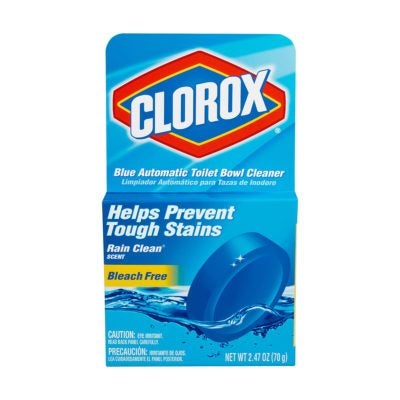– OR –
Ingredients Inside :Clorox® Automatic Toilet Bowl Cleaner (Rain Clean® Scent) 44600009490
-
Product Name and UPC: Clorox® Automatic Toilet Bowl Cleaner (Rain Clean® Scent) 44600009490
-
Brand: Clorox
-
Country: United States

Product Name and UPC: Clorox® Automatic Toilet Bowl Cleaner (Rain Clean® Scent) 44600009490
Product Ingredients
- Sodium Citrate
- Sodium citrate is used in laundry and hard surface cleaners to help remove soap scum and stains, and to help regulate the pH of the product. It is used in some hard surface cleaning products as a preservative.
- Hydroxyethylcellulose
- Hydroxyethylcellulose is a plant-derived thickener used in cleaning products such pre-wash stain removers and toilet bowl cleaners.
- Sodium Alkyllbenzenesulfonate
- Sodium C10-13 alkylbenzenesulfonate is a surfactant often used in cleaning products such as laundry detergents and soaps, and can also be used as a foaming agent in a cleaning products. It is one of the most effective cleaning agents for tough, greasy soils.
- Cocamide MEA
- Cocamide MEA (also known as coconut fatty acid amide) is a plant-derived surfactant comprising a 1:1 ratio of coconut fatty acid and monoethanolamine. It is used in household cleaning products and detergents to help remove soils, to stabilize foam, and to thicken the product.
- C.I. Acid Blue 9 (42090)
- C.I. Acid Blue 9 is a colorant (dye or pigment) added to cleaning products to improve aesthetic appeal, or to act as a tracer (for example in certain toilet bowl cleaners, blue coloration indicates that the product is working). They can be made from both synthetic and natural materials.
- Sodium Carbonate
- Sodium carbonate, also known as washing soda and soda ash, is an alkalinity builder, which is added to laundry detergents to improve cleaning efficiency. It also helps remove alcohol and grease stains from clothing. Builders act like water softeners, to remove calcium, magnesium and other ions found in tap water, that can interfere with the cleaning process.
- Sodium Lauryl Sulfate
- Sodium lauryl sulfate, also called SLS, is a surfactant commonly used in household cleaners, detergents and soaps because of its soil removing and foaming abilities.
- Fragrance
- Fragrances and perfumes are mixtures of fragrant essential oils, aroma compounds, fixatives and solvents. They are used in cleaning products to add a particular scent (lavender, lemon, etc.) to clothes and homes, and to mask unpleasant odors. Clorox provides a separate list of all the fragrance ingredients used in our household and professional cleaning, disinfecting and laundry products.
- Acrylic Copolymer
- Acrylic copolymers bind minerals such as calcium and magnesium (known as water hardness), enabling a cleaning product to remove hard water stains.
- Amorphous Silica
- Silica, also known as silicon dioxide or silica gel, is made from sand, reacted with compounds to purify it, and dried. Depending on its use, it can be an absorbant or a mild abrasive (for example, as used in cleaning products such as spot and stain removers).
- Alpha-Isomethyl Ionone
- Alpha-isomethyl ionone is a synthetic fragrance ingredient that is commonly used in personal care products. It has been identified as a potential allergen by the Scientific Committee on Consumer Safety, an advisory board to the European Union.
- Butylphenyl Methylpropional
- Butylphenyl methylpropional is a synthetic fragrance ingredient that appears as a colorless to pale yellow liquid with a powerful, floral-fresh odor. It is commonly used in cosmetics, personal care products, and cleaning products. It has been identified as a potential allergen by the Scientific Committee on Consumer Safety, an advisory board to the European Union.
- Citronellol
- Citronellol is a fragrance ingredient with a rose scent, and is naturally occurring in plants, such as geraniums and roses. It is a commonly used ingredient in cosmetics, personal care products, and cleaning products. It has been identified as a potential allergen by the Scientific Committee on Consumer Safety, an advisory board to the European Union.
- d-Limonene
- d-Limonene is used in cleaning products to help dissolve stains and soils and as a fragrance component. A member of a class of chemicals called terpenes, d-Limonene is obtained from the rinds of citrus fruits. It has been identified as a potential allergen by the Scientific Committee on Consumer Safety, an advisory board to the European Union..
- Hexyl Cinnamal
- Hexyl cinnamal is a fragrance ingredient that is found naturally in oil of chamomile. It has been identified as a potential allergen by the Scientific Committee on Consumer Safety, an advisory board to the European Union.
- Linalool
- Linalool is a fragrance ingredient that carries a floral odor, and is naturally produced from a wide variety of plants, such as cinnamon and citrus plants, and can also be produced synthetically. It is a commonly used ingredient in cosmetics, personal care products, and cleaning products. It has been identified as a potential allergen by the Scientific Committee on Consumer Safety, an advisory board to the European Union.
Clorox lists all fragrance components identified as potential allergens by the Scientific Committee on Consumer Safety, an advisory board to the European Union, when they are present at a concentration of more than 0.01 percent or greater in the product and provides a separate list of all the fragrance ingredients used in our household and professional cleaning, disinfecting and laundry products.
Product ingredients are listed based on the most current information available; please check back periodically for formulation updates. If you have questions regarding a product or the ingredient listing for a product, please contact us for additional information.
